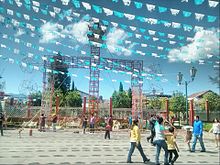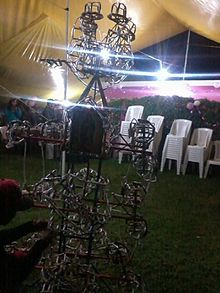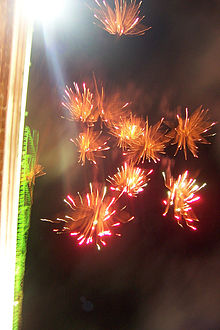Pyrotechnics
Pyrotechnics (in ancient Greek πῦρ pyr "fire") indicates a technology related to combustion, mostly explosive.
Devices that are prepared for pyrotechnic reactions to occur inside are called pyrotechnics. Pyrotechnic reactions occur by non-explosive combustion of materials, which can generate flames, sparks and smoke. Pyrotechnic devices may also contain elements for some controlled explosive reactions to occur. Pyrotechnic reactions can be initiated by electrical elements, and then ignite pyrotechnic devices that allow programming the occurrence of other pyrotechnic reactions. Pyrotechnic devices that have visual, sound and smoke effects for entertainment and entertainment purposes are known as "fireworks", "fireworks", "fireworks" or "pyrotechnic games". They are used in exhibitions, celebrations, festivities, celebrations, birthdays, commemorations, etc. It is considered an art, since there are multiple variations, games and techniques available to the pyrotechnic craftsman, and always in constant innovation. But pyrotechnics also includes a whole range for agricultural, military, industrial use, etc.
Raw materials
- Black gunpowder
- Steel, zinc and copper dust
- Potassium chlorate
- Sulphur
- Copper nitrate, beryllium nitrate and strontium
- Lithium chloride
Origin and terms
The origin of fireworks is directly related to the invention of gunpowder in China. The formula for this flammable material was brought to Europe by the Arabs during their great expansion through North Africa and Spain. The Arabs burst into the defenses of walled cities with the first firearms, such as the wall culverin, although this weapon was of small caliber and inefficient. In their occupation of the Iberian Peninsula, the Arabs laid the foundations[citation required] and the polvorista tradition also for recreational purposes in Murcia, Alicante and Valencia; these places with a long tradition of fire.
Pyrotechnic devices have been designed for special uses: forest fires, mining, construction, hail fighting, etc. But popularly, the term pyrotechnics is usually understood only as referring to fireworks. Fireworks: rockets, explosives or fireworks are widely used in all kinds of countries in the world and in Latin American countries, with significant sales of these products in places like Uruguay or Argentina; mainly on the occasion of the end-of-year festivities (Christmas Eve, Christmas, New Year's Eve or New Year), although they are also used in the celebration of the 15th birthday of women, the 18th birthday of men, baptisms, first communions, confirmations, marriage bonds, wedding anniversaries and other anniversaries.
There are countless products that create different results. The terms firecracker and rocket are colloquially widespread, covering almost all the varieties of explosion and existing pyrotechnic devices, but the nomenclature can be expanded as much as the diversity of effects:
- Finders or wheelbarrows.
- Pyrotechnic or housing pumps.
- Tracas or snakes, ballots, decks, masclets, etc.
- Bengal lights, fire wheels, etc.
- Palm trees, flyers, etc.
- Doves and popcorn, witches, etc.
The denomination of the products also varies according to the area, within the different regions of Spain or the world. A rocket or firecracker is said to be primed when it has not exploded correctly. In Alicante the term falluto is used to refer to the firecracker that did not explode.
Castles
A castle is called a structure of variable height and volume, formed with the purpose of achieving a spectacular range of effects, figures, different colored lights and sounds. by a massive amount of pyrotechnic products. where the ingenuity of the producer has a highly artistic role
In general, in Spain many castles are scheduled for traditional and popular festivals. The fireworks contests are especially relevant, in which different companies compete to achieve the best score. The competitions in San Sebastián (held around August 15 and the oldest in Spain) and Bilbao are very important. In Catalonia, there are Blanes, Gerona (the last week of July) and Tarragona (the first full week of July). Another contest is held in Alicante for the Bonfires of San Juan. In Navarra another younger contest takes place in Pamplona for San Fermín. Pyrotechnics is the protagonist in the popular festivals of many towns in the Catalan, Valencian, Murcian and Balearic communities.
One of the most famous and impressive spectacles in Spain is the one known as "Nit de l'Albà" (Night of Dawn in Spanish), which is It celebrates the night of every August 13 in the town of Elche. The fires that are fired during the "Fallas" festivities in the city of Valencia are very important, highlighting the so-called "La Nit del Foc" (the night of the fire) that takes place during the early hours of the day of San José (01:00 hours on March 19). Also worth mentioning is the "Entierro de la Sardina" in Murcia which ends with the Burning of the Sardine and a great fireworks display.
- In Catalonia: Popular demonstrations in which pyrotechnia is used, such as the actions of groups of fire, including processions, raisins and correfocswhere the "diable" and the beasts of fire of each people participate; what is most used are the elements called wheelbarrows and sinks French.
- In the Valencian Community: The tradition of castles and mascletà, an eminently sound trache where air and ground apparatus are combined. The practice of the correfocs, and in various villages are the known corda (much more historical).
- In the Region of Murcia: battles of trucks, the wheels and trousersbut also the castles to the passage of parades and processions, whether from the sea in towns of the coast, or on the street, or from high points within the towns.
Also using black powder for festive purposes is the arquebusry, which consists of the use of salute weapons, some of them of great artistic and sentimental value when passed from father to son. and that are used firing only gunpowder in honor of the patron or patron saint of the municipalities or to remember some historical acts such as embassies and guerrillas in the Moors and Christians festivals in many towns in Spain and its area of influence.
On the other hand, in Mexico a fixed land structure made of wooden or metal frames that can reach up to 45 meters in height is called castle from which fireworks and fireworks are hung.. These displays are finished off with pyrotechnic bombs. It is also known as "tower castle". There is a more traditional castle that is erected using a wooden post and an iron support base (also known as an andiron). This is lower, its structures are made from reeds, it has fewer fireworks and in recent years it is no longer so common, except in even more traditional towns such as San Sebastián from the south.
The Mexican towns that are famous for their fireworks tradition are Tultepec, Zumpango and Tlalchichilpan. In Tultepec, a town known as the pyrotechnics capital of Mexico, every year a National Fireworks Fair is held in which the tower castle and the Pyromusical contests stand out. The most popular pyrotechnic celebration is the “burning of bulls”, which takes place on March 8 in honor of San Juan de Dios, patron saint of Tultepec pyrotechnics.
The chemistry of fireworks
The colors of the fireworks are caused by the presence of salts caused by the combustion of the gunpowder and in this reaction energy is released which is visible, thanks to the electromagnetic spectrum, by specific wavelengths that reach our eyes giving a unique color to each cation of the salt.
In the initiative of the Federal Fireworks Law, in Mexico, 10 salts are considered as oxidants: potassium chlorate, barium chlorate, sodium chlorate, strontium chlorate, potassium perchlorate, ammonium perchlorate, barium nitrate, strontium nitrate, potassium nitrate and sodium nitrate but they are not the only compounds used. Regardless of the salt (chlorate or nitrate) it will be the cation that gives the color.
The purple color is provided by potassium (K), the orange is given by iron (Fe) and the yellow by sodium (Na). Green is produced by two elements:
Copper (Cu): Intense green.
Barium (Ba): Pale green, like apple green.
With the color red something similar happens with the color green, it is caused by two elements:
Lithium (Li): Soft red, it can even appear pink.
Strontium (Sr): Intense red, like scarlet.
Aluminum (Al) and magnesium (Mg) are also used, both of which emit white light.
Other uses of fireworks
The fireworks industry has several applications besides the show. The technical uses of pyrotechnics cover a wide range of industries such as agriculture, fishing, mining, automotive, etc.
- Pyrotechnic areas of identification and location: These are used in railways, land, air and sea transports, as well as for the location of people.
- Pyrotechnics of use in agriculture and cattle ranching: Some of the artifices used are fumonic boats, detonating strips and anti-granizo rockets for rain.
- Pyrotechnics for the fishing industry: This industry mainly uses three types of artifices for the development of its activity. The submarine bengala, which generates a water-resistant light effect; submarine megaton, which generates a sound effect; ink, which functions as a submarine marker.
- Pyrotechnics for the mining industry: This industry mainly uses explosives for its excavation activities.
- Pyrotechnic devices for military training and training: They are used, among other things, for blast simulation, shooting, etc.
- Pyrotechnic devices for the automotive industry: Gas generators are used for the activation of air bags.
Preventive considerations
Because they are explosive and ignition products, the danger of burns and fires is a potential corollary of high probability that must be taken into account, which is why in several countries there is control by entities also dedicated to the control of weapons and other explosive instruments like gunpowder itself, such as RENAR in Argentina.
A bad manipulation can cause accidental explosions, with amputation of parts of the hand or worse. These types of incidents are quite common in inexperienced people who occasionally acquire pyrotechnic skills for recreational purposes. As a basic rule, all fireworks should be lit on the ground, never while being held by hand; shells or supports for high-powered projectiles must be anchored to prevent tipping or drifting off course.
You must also take precautions when a device does not explode, because even if the fuse seems to have gone out, it can be activated and explode while being handled. Unsuccessful fireworks should be moved (with a stick or something similar) to a safe area and (if possible) doused with water to neutralize them.
Safety measures for the appropriate use of fireworks
- Buy and use only authorized products.
- Inexperience, curiosity and neglect in the management of pyrotechnic material increase the risk of accidents.
- Never buy or use clandestine pyrotechnia or suspected of having losses, defects or damage. Please note that there are clandestine products of dubious origin that do not indicate any employment instruction in your packaging or packaging. Apart from these precisions, the products must contain a safety fuse that prevents the artifice from turning on spontaneously. If the artifice is endowed with a lock (autofriccionante), do not buy it, it is very dangerous for children.
- Any burning of pyrotechnic artifices, no matter how large or small the product is always to be supervised by an adult.
- Do not shake, hit or smoke near pyrotechnic elements.
- Do not expose them for a long time to the sun or other heat sources.
- Do not use pyrotechnia if it is under the effect of alcohol or other substances that may affect your judgment, attention, movements or reflexes.
- If the product has unperfects in the wrapper or wick, do not buy it, and if it already did, do not use it, the risk is very large.
- Do not store pyrotechnic items in your pockets, these could turn on spontaneously and explode.
- Do not place the face or other parts of the body on an article when it is going to turn on.
- Try to light the fuse at the end so that it gives us enough time to retire.
- Do not fire rockets, balloons or other artifacts that produce fire less than 500 metres from forest areas.
- Launch rockets and other devices vertically and never against people or animals.
- Make sure there are no flammable fluids nearby.
- Products that do not have a special handle to take with their hands should be fixed to the earth, a pot or a bottle to prevent burns.
- Do not insert the firecrackers into bottles, boats, etc. because by exploiting the shrapnel or squirrels they can uncontrollably expand and hurt the people who are near.
- Never shoot the rockets with your hand. Always use a trigger and throw them vertically.
- Do not manipulate your components, or extract your content.
- Do not shoot them if they have defects, loss of pyrotechnic material or breakages.
- Once the wick is lit, withdraw immediately.
- If it fails on, wait 10 min. remembering the area. If the fuse is intact, you can try it again, otherwise enter the artifact into a container with water to disable it.
Legislation in Mexico
Pyrotechnics is an activity regulated by the Federal Law on Firearms and Explosives, published in 1972 under the regime of President Luis Echeverría Álvarez. This states that it is a legal and licit activity, as long as you purchase the fireworks authorized by the Secretary of National Defense, from natural or legal persons authorized for sale by the same secretary. By law, people over the age of 18 are authorized to carry up to 10 kg of fireworks.
This law does not make any distinction and regulates fireworks in the same way as firearms and explosives. On the other hand, there is an initiative of law that regulates the pyrotechnic activity exclusively called the Federal Law of Pyrotechnics. In it, raw materials and finished products are classified according to their use and degree of danger as follows:
See federal fireworks law.
Regulations for Spain
In Spain, the New Regulation of Pyrotechnic Articles and Cartridges RD 563/2010 and subsequent modification by Royal Decree 1335-2012 came into force with which it adapts to Directive 2007/23/CE, and repeals the previous regulations. This new text separates explosives from fireworks, which to date were governed by the same law. It also determines the restrictions and legislation for the use, trade and manufacture of fireworks, as well as grants local entities authority to authorize the firing and use of fireworks.
Individuals are only allowed to use Category I fireworks (users over 12 years of age), II (over 16 years of age) and III (over 18 years of age).
Traditionally, the pyrotechnic range suitable for individuals was limited to more or less powerful firecrackers and flares, but sources and batteries with successful visual effects are currently on the market. In these devices, by lighting a single fuse, multiple projectiles are activated that explode rhythmically and with safety guarantees, provided they are handled rationally and keeping the proper distance.
Regulations for Chile
Law No. 19,680 of May 25, 2000 regulates the sale, manufacture, and use of fireworks in Chile. This law establishes that the possession and manipulation of pyrotechnic elements is prohibited to the public and only allows their use by qualified personnel and experts in massive shows. Persons who violate the provisions of the law regarding the possession, handling, manufacture, and sale of these elements may be fined, the pyrotechnic elements seized, and the manufacturing, storage, and sale premises closed.
In December 2020, the Senate of the Republic approved a modification to the law to elevate the infraction from a misdemeanor to a crime so that offenders can receive not only fines, but also criminal punishment of up to 541 days. As of January 1, 2021, only the promulgation into law of this modification is pending.
Gallery
|
Recreational Pyrotechnics
In Spain it is customary to use pyrotechnic articles of a recreational nature to liven up celebrations or festivities, such as the beginning of the year, where we are used to witnessing different types of fireworks such as Castles, Mascletás, or the use of other materials such as firecrackers, bomblets, or flares with white or colored sparks.
For shows where handling and assembly of pyrotechnic devices is necessary, it will be necessary to do it by an expert company.
These items are classified by Royal Decree 989/2015, of October 30, which approves the Regulation of pyrotechnic items and ammunition as category F4 pyrotechnic items, and are highly dangerous fireworks intended for the exclusive use by of experts, also called "fireworks for professional use"
However, there are other types of devices that are for public use. Its classification is divided into 3 sections:
Category F1: For use by people over 12 years of age
Category F2: For use by people over 16 years of age
Category F3: for use by people over 18 years of age
It is very common to start and end local festivities with fireworks. Usually, the initial "Chupinazo" of festivities is the norm, which indicates the beginning of the festivities, the launch of rockets in processions and passes streets to indicate their departure, course and end, fireworks at the exit and collection of the virgin in the processions and a great fireworks display, like a great explosion of color and sound to end them. This practice is very common, although it depends on the areas of Spain where you reside.
In addition, in typical festivities such as weddings, the “shot” is customary, understanding this as the start or ignition of the fireworks, a fireworks at the end of the ceremony to indicate the departure of the couple from the church.
We can also find dates in the calendar in which the use and enjoyment of these recreational fireworks is traditionally held, such as the festival of San Juan on June 23 in Murcia. June, in Elche the celebration of the Nit del Albá on August 13 and the Festival of the Fallas in Valencia that take place every year in March.
Contenido relacionado
Graphic novel
International Electrotechnical Commission
Silicon controlled rectifier







